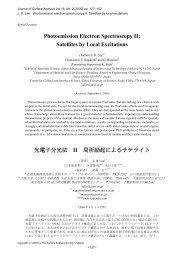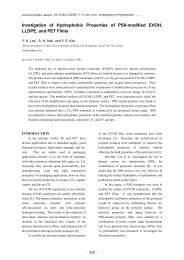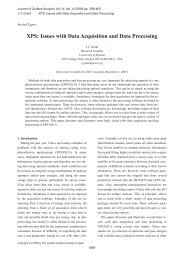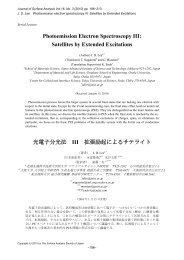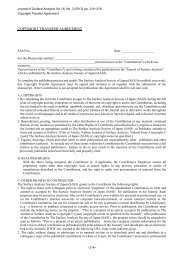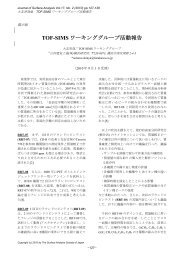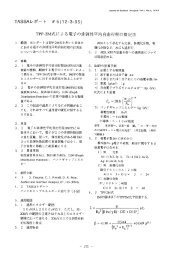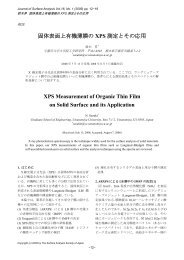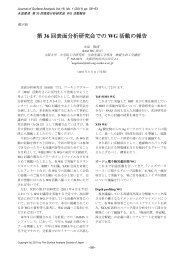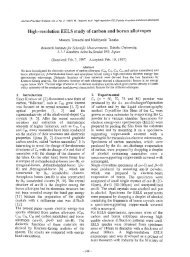Vol.15 No.2 150-158.pdf
Vol.15 No.2 150-158.pdf
Vol.15 No.2 150-158.pdf
Create successful ePaper yourself
Turn your PDF publications into a flip-book with our unique Google optimized e-Paper software.
Journal of Surface Analysis <strong>Vol.15</strong>, No. 2 (2008) pp. <strong>150</strong>−158<br />
T. Nagatomi et al. Inelastic Interaction of Medium-Energy Electrons with Ni Surface Studied by Absolute<br />
Reflection Electron Energy Loss Spectrum Analysis and Monte Carlo Simulation<br />
Review<br />
Inelastic Interaction of Medium-Energy Electrons with Ni<br />
Surface Studied by Absolute Reflection Electron Energy Loss<br />
Spectrum Analysis and Monte Carlo Simulation<br />
T. Nagatomi a,* and K. Goto b<br />
a Department of Material and Life Science, Graduate School of Engineering, Osaka University<br />
Suita, Osaka 565-0871, Japan<br />
b National Institute of Advanced Industrial Science and Technology (AIST) Chubu,<br />
Moriyama-ku, Nagoya, Aichi 463-8560, Japan<br />
* nagatomi@mls.eng.osaka-u.ac.jp<br />
(Received: February 15, 2008; Accepted: April 22, 2008)<br />
The results of the investigation of the inelastic interaction of medium-energy electrons with the Ni surface<br />
were described. The inelastic mean free path (IMFP), the surface excitation parameter (SEP) and the<br />
differential SEP (DSEP) were deduced simultaneously from an absolute reflection electron energy loss<br />
spectroscopy (REELS) spectrum. The present IMFPs show a good agreement with those calculated using<br />
the TPP-2M predictive equation. The dependence of the SEPs on the electron energy is similar to that calculated<br />
using Werner’s and Gertgely’s predictive equations. The DSEPs show a reasonable agreement with<br />
the theoretical DSEPs calculated using Tung’s theory with optical data. The derived IMFP, SEP and DSEP<br />
were applied to Monte Carlo simulation of REELS spectra, in which energy loss processes of signal electrons<br />
due to surface excitations were taken into account. The simulated REELS spectra reproduce the experimental<br />
absolute REELS spectra well without any fitting parameters, indicating that surface excitations<br />
play an important role in the inelastic interaction of medium-energy electrons with the solid surface.<br />
1. Introduction<br />
Quantitative information on the inelastic interaction of<br />
electrons with the solid surface has been important issue<br />
for quantitative surface chemical analysis by means of<br />
X-ray photoelectron spectroscopy (XPS), Auger electron<br />
spectroscopy (AES) and reflection electron energy loss<br />
spectroscopy (REELS). The inelastic mean free path<br />
(IMFP) is one of the most important parameters for<br />
quantification, which describes the decay of the peak<br />
intensity by inelastic interactions in solids. Recently,<br />
surface excitations have been proven to play an important<br />
role in inelastic interactions between electrons and<br />
solid surfaces. Surface excitations also cause the decay<br />
of the intensity of signal electrons during their transport<br />
in solids. The decay due to surface excitation is usually<br />
described by the surface excitation parameter (SEP)<br />
[1,2].<br />
The interaction of electrons with the solid surface has<br />
been intensively studied, and the determination of parameters<br />
such as the IMFP and SEP has been performed<br />
using experimental and theoretical approaches. One of<br />
the most widely used experimental approaches for such<br />
studies is the elastic peak electron spectroscopy (EPES)<br />
analysis [1,3-6]. Another experimental approach is the<br />
REELS analysis [7-13]. Both experimental approaches<br />
are found to be effective for determining IMFP and SEP.<br />
The EPES analysis requires a reference material and<br />
the IMFP or SEP as input data for determining the SEP<br />
or IMFP. The REELS analysis does not require any reference<br />
material and can determine the differential SEP<br />
(DSEP) describing energy loss probability due to single<br />
surface excitation event in addition to SEP or IMFP.<br />
However, the REELS analysis also requires the IMFP or<br />
SEP as an input data. Recently, a procedure for determining<br />
the differential inelastic mean free path (DIMPF)<br />
and DSEP from two REELS spectra using the elastic<br />
Copyright (c) 2008 by The Surface Analysis Society of Japan<br />
−<strong>150</strong>−
Journal of Surface Analysis <strong>Vol.15</strong>, No. 2 (2008) pp. <strong>150</strong>−158<br />
T. Nagatomi et al. Inelastic Interaction of Medium-Energy Electrons with Ni Surface Studied by Absolute<br />
Reflection Electron Energy Loss Spectrum Analysis and Monte Carlo Simulation<br />
cross section and an estimate for the IMFP as input parameter<br />
[14] has been proposed. The authors have also<br />
been involved in the study on the interaction of electrons<br />
with solid surface [15-19], and recently proposed an<br />
analytical approach to determine simultaneously the<br />
IMFP, SEP and DSEP with absolute units from on absolute<br />
REELS spectrum [20,21]. The proposed approach<br />
requires only the normalized DIMFP and the elastic<br />
scattering cross section as input parameters.<br />
With respect to the theoretical approach for studying<br />
the interaction of electrons with solid surfaces, theoretical<br />
studies based on the dielectric response of solid to<br />
external charged particles has been intensively performed<br />
[15,22-25]. Another powerful theoretical approach for<br />
understanding the interaction of electrons with the solid<br />
surface is Monte Carlo (MC) simulation of an electron<br />
spectrum. However, most of the MC simulations of electron<br />
spectrum do not take into account the surface excitation,<br />
and only a few MC simulation codes take it into<br />
account [24]. The authors investigated simple modeling<br />
of MC simulation of the REELS spectrum by taking into<br />
account energy loss processes by surface excitations [26].<br />
In the developed MC simulation, the IMFP, SEP and<br />
DSEP determined by the REELS analysis can be used for<br />
describing the inelastic interactions of electrons with<br />
solids.<br />
In the present paper, the results of the investigation of<br />
the inelastic interaction of medium-energy electrons with<br />
the Ni surface using the analytical approach proposed by<br />
the authors were described. The determined IMFP, SEP,<br />
and DSEP are discussed by comparing with those calculated<br />
by predictive equations and/or theory. The results<br />
of the application of those parameters to the MC simulation<br />
of the REELS spectra were also described.<br />
2. Experimental<br />
All experiments were performed using a noble cylindrical<br />
mirror analyze (CMA) developed by one of the<br />
authors (K.G.) [27]. The CMA equipped with a Faraday<br />
cup as a detector, and provides the absolute current of<br />
signal electrons. The base pressure of the apparatus was<br />
2×10 -8 Pa. The sample was a polycrystalline Ni, and its<br />
surface was cleaned by sputter cleaning using 250-300<br />
eV Ar + ions. The primary energy of electrons for the<br />
REELS measurement was varied from 300 to 3000 eV.<br />
The beam current was 1 μA. The incident and detection<br />
angles of electrons were the surface normal and 42.3±6°.<br />
The energy resolution was 0.25%. The transmission<br />
function of the CMA used for the correction of the intensity<br />
scale of spectra was that estimated by the measurement<br />
of the transmission of light [1]. The experimental<br />
setup is detailed elsewhere [1].<br />
3. Analytical approach<br />
In the present analytical approach, the IMFP, SEP and<br />
DSEP are simultaneously determined from an absolute<br />
REELS spectrum. The approach is based on the Landau<br />
theory [28] originally describing the energy losses of<br />
electrons in solids when the angular deflection of electrons<br />
can be neglected. The Landau theory can be extended<br />
by taking into account angular deflections of<br />
moving electrons by elastic scattering and energy losses<br />
by surface excitations, and may be given by [20,21]<br />
J<br />
∞<br />
in l<br />
[ P ]<br />
m total, l in<br />
() s = F() s ∑α<br />
m[ λbK<br />
b<br />
() s ] ∑ Ps<br />
Ks<br />
() s<br />
∞<br />
m= 0 l=<br />
0<br />
where J(s) and F(s) are the Fourier transforms of a<br />
measured REELS spectrum J(E) and the energy distribution<br />
of primary electrons F(E). s is the Fourier parameter<br />
conjugate to the energy E. The first and second Σ terms<br />
with respect to the summation over m and l describe the<br />
transport of electrons in the bulk and energy loss processes<br />
by surface excitations, respectively.<br />
m in the first Σ term is the number of bulk excitation<br />
events and α m describes the probability that electrons<br />
participate in m-fold bulk excitation events in solids. λ b<br />
is the IMFP and K b (s) is the Fourier transform of the<br />
DIMFP for bulk excitation K(ΔE), where ΔE is the energy<br />
loss. K(ΔE) satisfies the following relation with λ b<br />
1 = λ<br />
b<br />
∫<br />
Ep<br />
0<br />
K ( ΔE) d( ΔE) (2)<br />
b<br />
l in the second Σ term is the number of surface excitation<br />
events and P s is the probability that electrons<br />
total,l<br />
participate in l-fold surface excitation events. Note that<br />
l>2 is even possible since an electron can participate in<br />
surface excitation events more than twice when it cross<br />
the surface once [29], though the possibility is very low<br />
as confirmed in Fig. 5 below. P in s and K in s (s) are the SEP<br />
and the Fourier transform of the DSEP K in s (ΔE) for incoming<br />
electrons. P in s and K in s (ΔE) satisfies,<br />
s<br />
(1)<br />
−151−
Journal of Surface Analysis <strong>Vol.15</strong>, No. 2 (2008) pp. <strong>150</strong>−158<br />
T. Nagatomi et al. Inelastic Interaction of Medium-Energy Electrons with Ni Surface Studied by Absolute<br />
Reflection Electron Energy Loss Spectrum Analysis and Monte Carlo Simulation<br />
P s total,l is given by<br />
P<br />
total, l<br />
s<br />
k −1<br />
( ) ∫<br />
E p k<br />
Ps<br />
K<br />
s<br />
( ΔE) d(<br />
1 =<br />
ΔE)<br />
l<br />
= ∑<br />
0<br />
[ ( )] ( l-l<br />
) in l<br />
in<br />
Θ θ<br />
in<br />
, θ<br />
out<br />
( Ps<br />
)<br />
lin!<br />
( l - l )!<br />
exp − [ 1+ Θ( θ , θ )]<br />
lin<br />
= 0 in<br />
in<br />
× {<br />
in out<br />
Ps<br />
( θ )<br />
in<br />
out<br />
in<br />
out<br />
}<br />
(3)<br />
(4)<br />
Θ θ , = cosθ<br />
cosθ<br />
(5)<br />
where l=l in +l out , and l in and l out are the number of surface<br />
excitation events undergone by a signal electron on its<br />
incoming and outgoing trajectories, respectively. θ in and<br />
θ out are the incident and emission angle of the signal<br />
electron, respectively.<br />
In the present analysis, a REELS spectrum is<br />
self-consistently deconvoluted into components relevant<br />
to electrons participating in m-fold bulk (m=0, 1, 2, …)<br />
and l-fold surface (l=0, 1, 2, …) excitation events using<br />
eq. (1). A REELS spectrum, J(E), is obtained by correcting<br />
the intensity of the REELS spectrum using the<br />
transmission function. The energy distribution of primary<br />
electrons, F(E), is deduced from the elastic peak of the<br />
REELS spectrum. The DIMFP, K(ΔE), is calculated using<br />
the dielectric response theory [30] with the Penn’s<br />
algorithm [31] based on the Ritchie-Howie algorithm<br />
[32] for the extension of the ω-dependent energy loss<br />
function to the momentum-energy loss space,<br />
K<br />
b<br />
( ΔE)<br />
1 Ep<br />
⎡ −<br />
× Im⎢<br />
⎣ε<br />
∫<br />
⎤<br />
d( hω0<br />
)<br />
( ΔE<br />
− hω<br />
)<br />
=<br />
hω0<br />
2π a E<br />
0<br />
ΔE<br />
(6)<br />
0<br />
0<br />
2<br />
1 ⎡<br />
⎤<br />
⎥ ⎢ ( − ) − Δ ⎥<br />
( ) Θ h<br />
2<br />
2kq<br />
q E<br />
ω 2m<br />
⎦<br />
0<br />
⎦<br />
where a 0 is the Bohr radius, Θ(x) is the step function<br />
representing the lows of momentum and energy conservation.<br />
h q is the momentum transfer satisfying<br />
⎣<br />
2<br />
ΔE = h ω + q 2m<br />
(7)<br />
0<br />
h<br />
2<br />
0<br />
The energy loss function was calculated from optical<br />
data [33]. Then, the normalized DIMFP, λ b K(ΔE), is obtained<br />
by multiplying K(ΔE) by λ b .<br />
For deconvolution procedure, the path-length distribution,<br />
dη/dx, is calculated by MC simulation, in which<br />
only the angular deflection by elastic scattering is taken<br />
into account (Model I below). Using dη/dx, α m is calculated<br />
by<br />
m<br />
∫ ∞ dη<br />
1 ⎛ x ⎞ ⎛ x<br />
= ⎜<br />
⎟ exp<br />
⎜<br />
m<br />
−<br />
0 dx m!<br />
λb<br />
λb<br />
⎟ ⎞<br />
α dx . (8)<br />
⎝ ⎠ ⎝ ⎠<br />
Using experimentally obtained J(s) and F(s), and calculated<br />
λ b K(ΔE) and α m , P s in and K s in (ΔE) are uniquely<br />
determined by deconvolution according to eq. (1). However,<br />
P s in and K s in (ΔE) obtained at this stage of the analysis<br />
does not satisfy the physically defined eq. (3). Therefore,<br />
as the next step of the analysis, λ b . is modified, and<br />
P in s and K in s (ΔE) are deduced again using modified α m in<br />
the same manner. Modifying λ b and deducing P in s and<br />
K in s (ΔE) are repeated as iterative procedures until the<br />
deduced P in s and K in in<br />
s (ΔE) satisfy eq. (3). Finally, λ b , P s<br />
and K in s (ΔE) are self-consistently determined. Details of<br />
the present absolute REELS analysis and several assumptions<br />
made for the theoretical approach are described<br />
elsewhere [20,21].<br />
Note that the more detailed transmission function of<br />
the CMA has just been reported by one of the authors<br />
(K.G.) [34]. The difference in the transmission function<br />
between that used in the present study basing on the optical<br />
measurement and that more precisely measured using<br />
mini electron gun may introduce significant difference<br />
in the obtained SEP when the SEP is determined<br />
from only the absolute elastic peak intensity [35]. In<br />
contrast, the SEP obtained by the present analysis might<br />
not be affected significantly since both SEP and IMFP<br />
were determined simultaneously and the background of<br />
spectra is also used as well as the elastic peak. Further<br />
investigation using the newly measured transmission<br />
function is underway.<br />
4. Monte Carlo simulation<br />
4.1. Model I (only elastic scattering)<br />
For calculating the path-length distribution, dη/dx, required<br />
for the REELS analysis, the electron trajectories<br />
are simulated by taking into account only the elastic<br />
scattering as the type of scattering. The step length Λ<br />
between two successive elastic collision events is determined<br />
by an uniform random number R 1 ∈[0,1] within<br />
the scheme of the Poisson stochastic process as,<br />
Λ = −λ elastic<br />
ln( R 1<br />
) (9)<br />
where λ elastic is the elastic mean free path.<br />
−152−
Journal of Surface Analysis <strong>Vol.15</strong>, No. 2 (2008) pp. <strong>150</strong>−158<br />
T. Nagatomi et al. Inelastic Interaction of Medium-Energy Electrons with Ni Surface Studied by Absolute<br />
Reflection Electron Energy Loss Spectrum Analysis and Monte Carlo Simulation<br />
The scattering angle φ is determined by the random<br />
number R 2 as<br />
R<br />
2<br />
φ<br />
∫0<br />
=<br />
π<br />
∫<br />
0<br />
dσ<br />
dφ′<br />
dσ<br />
dφ′<br />
elastic<br />
elastic<br />
dφ′<br />
dφ′<br />
(10)<br />
where dσ elastic /dφ is the differential elastic scattering<br />
cross section. The elastic mean free path and differential<br />
elastic scattering cross section were calculated using<br />
Mott cross sections calculated with the partial-wave expansion<br />
method using the Thomas-Fermi-Dirac potential<br />
[36-38].<br />
4.2. Model II (with inelastic scattering)<br />
In Model II, the inelastic scattering due to both bulk<br />
and surface excitations are taken into account as the type<br />
of scattering in order to simulate REELS spectra. The<br />
step length Λ between two successive collision events in<br />
the bulk is determined using eq. (11) instead of (9)<br />
( )<br />
= −λ total ln R 3<br />
Λ<br />
-1 -1 -1<br />
total<br />
= λelastic<br />
λb<br />
where λ total is the total mean free path given by,<br />
λ +<br />
(11)<br />
. (12)<br />
The type of scattering is determined by another random<br />
number R 4 as<br />
-1 -1<br />
⎧ elastic, for R4<br />
< λ<br />
elastic<br />
λtotal<br />
. (13)<br />
⎨<br />
⎩inelastic<br />
otherwise<br />
When the type of scattering is the elastic collision, the<br />
scattering angle is determined as that in Model I described<br />
above. When the type of scattering is the inelastic<br />
collision, the amount of the energy loss ΔE by bulk excitation<br />
is determined by<br />
R<br />
=<br />
ΔE<br />
∫0<br />
∫<br />
5 Ep<br />
0<br />
λ K<br />
b<br />
λ K<br />
b<br />
b<br />
b<br />
( ΔE′<br />
) d(<br />
ΔE′<br />
)<br />
( ΔE′<br />
) d( ΔE′<br />
)<br />
. (14)<br />
Details of the MC modeling of REELS spectra, where<br />
only bulk excitations are taken into account as inelastic<br />
collisions, are described elsewhere [39,40].<br />
In order to describe energy losses by surface excitations<br />
in MC simulation, the Poisson stochastic process<br />
was assumed. Signal electrons undergo surface excitations<br />
when they cross the surface on their incoming and<br />
outgoing ways. The numbers of surface excitation events<br />
experienced by incident and backscattered electrons<br />
crossing the surface on their incoming and outgoing trajectories,<br />
L in and L out , respectively, are determined by<br />
P l k<br />
L −1<br />
k<br />
∑<br />
l=<br />
0<br />
∞<br />
∑<br />
l=<br />
0<br />
p<br />
p<br />
k<br />
l<br />
k<br />
l<br />
< R<br />
6<br />
<<br />
L<br />
k<br />
∑<br />
l=<br />
0<br />
∞<br />
∑<br />
l=<br />
0<br />
p<br />
p<br />
k<br />
l<br />
k<br />
l<br />
(15)<br />
is the probability that the electron participates in<br />
l-fold surface excitation events on its incoming (k=in)<br />
and outgoing (k=out) trajectories. P l k satisfies the relation<br />
∑ ∞<br />
k<br />
p l<br />
l=0<br />
= 1<br />
(16)<br />
and expressed using SEP for incoming and outgoing<br />
electrons, P in s and P out s , by<br />
p<br />
k<br />
l<br />
k l<br />
k<br />
( P ) ( − P<br />
1<br />
=<br />
s<br />
exp<br />
s<br />
) . (17)<br />
l !<br />
The amount of the energy loss ΔE by a single surface<br />
excitation event is determined using<br />
R<br />
=<br />
ΔE<br />
∫0<br />
∫<br />
7 Ep<br />
0<br />
k −1<br />
k<br />
( P ) ( ′) ( ′<br />
s<br />
K<br />
s<br />
ΔE<br />
d ΔE<br />
)<br />
k −1<br />
k<br />
( P ) K ( ΔE′<br />
) d( ΔE′<br />
)<br />
s<br />
s<br />
. (18)<br />
Here, P in s and P out s , and K in s (ΔE) and K out s (ΔE) are assumed<br />
to satisfy the relations<br />
in<br />
( ΔE) = Θ( θ ) K ( ΔE)<br />
out<br />
Ks in<br />
,θ<br />
P<br />
out<br />
( θ ) in<br />
out<br />
s<br />
= Θ θ<br />
in<br />
,<br />
out<br />
Ps<br />
s<br />
(19)<br />
. (20)<br />
In the case of the multiple surface excitation (L in ≥2 or<br />
L out ≥2), the total amount of energy loss due to L k -fold<br />
surface excitation events is calculated by repeating the<br />
calculation of eq. (18) L k times.<br />
In the model II of the MC simulation, the values of the<br />
IMFP λ b , SEP P k s and DSEP K k s (ΔE), are described by<br />
those absolutely determined by the present REELS<br />
analysis. During the transport of a signal electron in solids,<br />
the mean free path, elastic cross section, DIMFP,<br />
SEP and DSEP are changed depending on the kinetic<br />
energy of the electron. In the present MC simulation,<br />
however, we significantly reduced the calculation time<br />
by assuming that the values of those parameters for the<br />
certain primary energy can be used during calculating a<br />
−153−
Journal of Surface Analysis <strong>Vol.15</strong>, No. 2 (2008) pp. <strong>150</strong>−158<br />
T. Nagatomi et al. Inelastic Interaction of Medium-Energy Electrons with Ni Surface Studied by Absolute<br />
Reflection Electron Energy Loss Spectrum Analysis and Monte Carlo Simulation<br />
REELS spectrum at the corresponding primary energy.<br />
As observed later, this is a reasonable assumption since<br />
we simulated REELS spectra for the maximum energy<br />
loss of 50 to 100 eV depending on the primary energy,<br />
which is small enough to regard those parameters to be<br />
independent on the kinetic energy of electrons.<br />
confirming that the present approach is effective for the<br />
experimental determination of IMFPs.<br />
5. Results and discussion<br />
Figure 1 shows response functions and their deconvolution<br />
into components due to m-fold bulk and l-fold<br />
surface excitations. The response function was obtained<br />
by the inverse Fourier transform of J(s)/F(s), which corresponds<br />
to the energy loss distribution for one primary<br />
electron. It is found that the relative contribution of the<br />
components due to surface excitations (s 1 and s 2 ) is larger<br />
than those due to bulk excitations (b 1 and b 2 ) for the<br />
lower primary energy. The energy loss processes in the<br />
low-energy loss region near the elastic peak is dominated<br />
by surface excitations for low-energy electrons. Note that<br />
the lower order components with m+l≤2, in particular,<br />
those due to single surface (s 1 , m=0 and l=1) and single<br />
bulk (b 1 , m=1 and l=0) excitations, form most of the energy<br />
loss spectra in the energy loss region of 0-40 eV<br />
near the elastic peak, which is important for background<br />
subtraction in quantitative analysis.<br />
In Fig. 2, the IMFP determined by the present analysis,<br />
λ pre b , is compared with that calculated by the TPP-2M<br />
predictive equation [41], λ TPP-2M b . The plots of the percentage<br />
difference of λ pre b from λ TPP-2M b calculated by<br />
[42]<br />
Fig.1. Response functions of REELS spectra for Ni and their<br />
deconvolution into components relevant to m-fold bulk and<br />
l-fold surface excitations at primary energies of (a) 300 and (b)<br />
2000 eV. The components satisfying m+l≤2 are shown. The<br />
components corresponding to m+l=2 are multiplied by a factor<br />
of 4. Single surface excitation (s 1 , m=0 and l=1): thick solid<br />
line. Single bulk excitation (b 1 , m=1 and l=0): thin solid line.<br />
Twofold surface excitation (s 2 , m=0, l=2): thick dotted line.<br />
Twofold bulk excitation (b 2 , m=2 and l=0): thin dotted line.<br />
Single surface and single bulk excitations (b 1 s 1 , m=1 and l=1).<br />
b<br />
Δ λ =<br />
×<br />
(21)<br />
b<br />
b<br />
pre TPP-2M<br />
TPP-2M<br />
( λ − λ ) 100 λ<br />
b<br />
is also shown. The agreement between λ pre TPP-2M<br />
b and λ b<br />
is found to be fairly good. Δλ b is slightly positive at low<br />
energies and negative for high energies. For further<br />
pre<br />
quantitative comparison of λ b and λ TPP-2M b , the<br />
root-mean-square (RMS) difference Δλ RMS b was calculated.<br />
Δλ RMS b is defined as [42]<br />
RMS 1<br />
2<br />
Δλ =<br />
(22)<br />
b<br />
r<br />
pre TPP-2M<br />
∑ ( λ − λ )<br />
b b<br />
r j=<br />
1<br />
where r is the number of IMFP data values, and was calculated<br />
to be 3.1 Å,. Thus, Δλ RMS b value indicates that<br />
the IMFPs deduced from the present absolute analysis<br />
agree reasonably well with the theoretical predictions,<br />
Fig. 2. IMFPs determined by the present analysis λ b pre (solid<br />
circles). Open circles represent the IMFPs calculated using the<br />
TPP-2M predictive equation, λ b TPP-2M . Δλ b is the percentage<br />
difference between the present IMFPs and those calculated<br />
using the TPP-2M equation.<br />
−154−
Journal of Surface Analysis <strong>Vol.15</strong>, No. 2 (2008) pp. <strong>150</strong>−158<br />
T. Nagatomi et al. Inelastic Interaction of Medium-Energy Electrons with Ni Surface Studied by Absolute<br />
Reflection Electron Energy Loss Spectrum Analysis and Monte Carlo Simulation<br />
Figure 3 shows plots of the SEPs deduced by the present<br />
REELS analysis. The present SEPs are fitted with<br />
the simple Chen equation [2],<br />
a ⎛ 1 1 ⎞<br />
P =<br />
⎜ +<br />
⎟ (23)<br />
s<br />
E ⎝ cosθin<br />
cosθout<br />
⎠<br />
This fit gives a=4.3 (eV 1/2 ) with an RMS deviation of<br />
0.038, as plotted by the thick solid line. It is found that<br />
the present SEPs show reasonable agreement with those<br />
calculated using predictive equations of the SEP in Ni<br />
reported by Werner [43] and Gergely [44]. Note that<br />
plots in Fig. 5 show a slightly complicated dependence<br />
on the energy rather than the straight line in log-log plot<br />
that expected from the theoretical prediction. For better<br />
comparison with other predictive equations and for a<br />
more simple formula for the correction, fitting to the<br />
simple Chen’s equation was performed.<br />
shown in (c). A comparison between (a) and (b) reveals<br />
that the present DSEP shows the fairly good overall<br />
agreement with the theoretical prediction. In both figures,<br />
the most probable energy loss by single surface excitation<br />
is found to be approximately 7.5 eV. A comparison<br />
between (b) and (c) indicates the energy loss processes in<br />
the low-energy loss region is dominated by surface excitations.<br />
Differences between the present DSEPs and<br />
theoretical results are observed for energy losses larger<br />
than 15 eV. This might be due to the deficiencies in the<br />
optical data used for the calculation of the normalized<br />
DIMFP and for parameterization of the model dielectric<br />
function [21].<br />
Fig. 3. SEPs deduced by the present analysis. Thin dotted and<br />
long dash lines represent the SEPs calculated using Werner’s<br />
equation [43] and Gergely’s equation [44], respectively. The<br />
thick solid line shows the fitted curve [eq. (22)].<br />
Figure 4(a) shows the DSEP for incoming electron, the<br />
incident angle of which is 0°, obtained by the present<br />
analysis for electrons of 300, 800 and 1200 eV. For<br />
comparison, the DSEPs theoretically calculated using<br />
Tung’s model [45] are shown in (b). For the theoretical<br />
calculation, the dielectric function modeled by fitting a<br />
Drude-Lindhard type of expansion to optical data [45]<br />
was used. The fitting parameters for Ni are listed in the<br />
literature [21]. The DIMFPs, the intensity of which, i.e.,<br />
the IMFP, was determined by the present study, are also<br />
Fig. 4. (a) DSPEs obtained by the present study. (b) DSEPs<br />
calculated using Tung’s model [45]. (c) DIMFPs determined in<br />
the present study. The primary energy of electrons are 300, 800<br />
and 1200 eV.<br />
Figures 5(a) and (b) show the probability α m P total,l s of<br />
primary electrons of 300 and 2000 eV participating in<br />
m-fold bulk and l-fold surface excitations in the present<br />
REELS measurement. The contribution of multiple surface<br />
excitation events (l≥2) is higher for the lower primary<br />
energy. The contribution of twofold surface excitation<br />
events is ~20% of that of l=0 for 300 eV, and decreases<br />
to only a few % for 2000 eV. These results indi-<br />
−155−
Journal of Surface Analysis <strong>Vol.15</strong>, No. 2 (2008) pp. <strong>150</strong>−158<br />
T. Nagatomi et al. Inelastic Interaction of Medium-Energy Electrons with Ni Surface Studied by Absolute<br />
Reflection Electron Energy Loss Spectrum Analysis and Monte Carlo Simulation<br />
cate that the contribution of surface excitations strongly<br />
depends on the energy of signal electrons. This primary<br />
energy dependence reveals that care concerning surface<br />
excitations is required for the improvement of the accuracy<br />
of quantification using surface electron spectroscopy.<br />
Figure 6 shows the REELS spectra calculated using<br />
the present MC simulation with Model II, where energy<br />
losses by surface excitations are taken into account. For<br />
comparison, the experimental spectra and those simulated<br />
without taking into account surface excitations are<br />
shown. It is confirmed that the present MC simulation<br />
with Model II reproduces the absolute intensity of both<br />
the elastic peak and the background very well without<br />
any fitting parameters. The same degree of the agreement<br />
was observed for all other REELS spectra obtained at<br />
different primary energies. In contrast, the MC simulation<br />
without surface excitations significantly overestimates<br />
the elastic peak intensity. The background intensity<br />
near the elastic peak, where contribution of energy<br />
losses by surface excitations is significant, are underestimated.<br />
These results suggest that quantitatively understanding<br />
of AES and XPS spectra requires information<br />
on energy loss processes due to surface excitations in the<br />
energy loss region near the elastic peak.<br />
Fig. 5. Probability of electrons participating in m-fold bulk and<br />
l-fold surface excitation events in the present REELS measurement.<br />
The primary energy of electrons are (a) 300, (b) 2000<br />
eV, respectively.<br />
Fig. 6. REELS spectra simulated by MC simulation, in which<br />
energy loss processes by surface excitation is taken into account<br />
(thick solid line). The primary energies of electrons are<br />
(a) 300 and (b) 2000 eV. Thin solid line shows the experimental<br />
absolute REELS spectra. Dotted line represents the simulated<br />
spectra without taking into account surface excitations.<br />
The experimental spectra and spectra simulated without surface<br />
excitation were shifted towards the lower energy side for better<br />
comparison. The spectra simulated without surface excitations<br />
are multiplied by the factor of 0.5 for better comparison of the<br />
overestimated elastic peak intensity. Insets show the background<br />
of the spectra on an enlarged scale.<br />
Note that the simulated spectra tend to underestimate<br />
the intensity of the background at the tail of the elastic<br />
peak at the lower energy side. This tendency is significant<br />
for the lower primary energy. This is attributed to<br />
the uncertainty in the elastic peak profile. The higher the<br />
primary energy is, the smaller the underestimation is,<br />
−156−
Journal of Surface Analysis <strong>Vol.15</strong>, No. 2 (2008) pp. <strong>150</strong>−158<br />
T. Nagatomi et al. Inelastic Interaction of Medium-Energy Electrons with Ni Surface Studied by Absolute<br />
Reflection Electron Energy Loss Spectrum Analysis and Monte Carlo Simulation<br />
since fine loss structures are smeared out at higher primary<br />
energies because of the lower energy resolution. It<br />
should be noted that the underestimation of the elastic<br />
peak intensity observed in Fig. 5(a) is less than 1%,<br />
causing almost no error in quantification.<br />
6. Summary<br />
The analytical approach to deduce the IMFP, SEP and<br />
DSEP from an absolute REELS spectrum and the results<br />
of the analysis are outlined. The results of the application<br />
of the obtained IMFP, SEP and DSEP to MC simulation<br />
of REELS spectra are also described. The present approach<br />
is one of the powerful approaches to experimentally<br />
determine absolutely the IMFP, SEP and DSEP for<br />
medium-energy electrons. The investigation of the<br />
REELS spectra by MC simulation is also effective to<br />
understand the interaction of medium-energy electrons<br />
with solid surface. Further investigation using the present<br />
analytical approach with the newly measured transmission<br />
function [34] is underway.<br />
7. References<br />
[1] S. Tanuma, S. Ichimura, and K. Goto K, Surf.<br />
Interface Anal. 30, 212 (2000).<br />
[2] Y. F. Chen, Surf. Sci. 519, 115 (2002).<br />
[3] J. Zemek, P. Jiricek, B. Lesiak, and A. Jablonski, Surf.<br />
Sci. 531, L335 (2003).<br />
[4] G. Gergely, M. Menyhard, S. Gurban, J. Toth, and D.<br />
Varga, Surf. Interface Anal. 36, 1098 (2004).<br />
[5] G. Gergely, M. Menyhard, S. Gurban, J. Toth, and D.<br />
Varga, Surf. Interface Anal. 36, 1098 (2004).<br />
[6] S. Gurban, G. Gergely, J. Toth, D. Varga, A. Jablonski,<br />
and M. Menyhard, Surf. Interface Anal. 38, 624<br />
(2006).<br />
[7] W. S. M. Werner, W. Smekal, C. Tomastik, and H.<br />
Störi, Surf. Sci. 486, L461 (2001).<br />
[8] W. S. M. Werner, Surf. Sci. 526, L159 (2003).<br />
[9] W. S. M. Werner, Surf. Interface Anal. 35, 347<br />
(2003).<br />
[10] W. S. M. Werner, L. Köver, S. Egri, J. Tóth, and D.<br />
Varga, Surf. Sci. 585, 85 (2005).<br />
[11] G. Gergely, M. Menyhard, S. Gurban, A. Sulyok, J.<br />
Toth, D. Varga, and S. Tougaard, Solid State Ionics<br />
141-142, 47 82001).<br />
[12] G. Gergely, M. Menyhard, S. Gurban, A. Sulyok, J.<br />
Toth, D. Varga, S. Tougaard, Surf. Interface Anal.<br />
33, 410 (2002).<br />
[13] S. Gurban, G. Gergely, M. Menyhard, J. Adam, A.<br />
Adamik, Cs. Daroczi, J. Toth, D. Varga, A. Csik,<br />
and S. Tougaard, Surf. Interface Anal. 34, 206<br />
(2002).<br />
[14] W. S. M. Werner, Phys. Rev. B 74, 075421 (2006).<br />
[15] T. Nagatomi, R. Shimizu, and R. H. Ritchie, Surf.<br />
Sci.419, 158 (1999).<br />
[16] T. Nagatomi, Z. J. Ding, and R. Shimizu, Surf. Sci.<br />
359, 163 (1996).<br />
[17] T. Nagatomi, T. Kawano, H. Fujii, E. Kusumoto,<br />
and R. Shimizu, Surf. Sci. 416, 184 (1998).<br />
[18] T. Nagatomi, T. Kawano, and R. Shimizu, J. Appl.<br />
Phys.83, 8016 (1998).<br />
[19] T. Nagatomi, R. Shimizu, and R. H. Ritchie, J. Appl.<br />
Phys. 85, 4231 (1999).<br />
[20] T. Nagatomi and K. Goto, Appl. Phys. Lett. 87,<br />
224107 (2005).<br />
[21] T. Nagatomi and K. Goto, Phys. Rev. B 75, 235425<br />
(2007).<br />
[22] Y. F. Chen and Y. T. Chen, Phys. Rev. B 53, 4980<br />
(1996).<br />
[23] C. M. Kwei, C. Y. Wang, and C. J. Tung, Surf. Interface<br />
Anal. 26, 682 (1998).<br />
[24] Z. J. Ding, H. M. Li, Q. R. Pu, Z. M. Zhang, and R.<br />
Shimizu, Phys. Rev. B 66, 085411 (2002).<br />
[25] F. Yubero and S. Tougaard, Phys. Rev. B 71, 045414<br />
(2005).<br />
[26] T. Nagatomi and K. Goto, Surf. Interface Anal.<br />
(submitted).<br />
[27] K. Goto, N. Sakakibara, and Y Sakai,. Microbeam<br />
Anal. 2, 123 (1993).<br />
[28] L. Landau, J. Phys. (Moscow) 8, 201 (1944).<br />
[29] T. Nagatomi and K. Goto, J. Surf. Anal. 13, 212<br />
(2006) (in Japanese).<br />
[30] D. Pines, Elementary Excitations in Solids (W. A.<br />
Benjamin, New York, 1964).<br />
[31] D. R. Penn, Phys. Rev. B 35, 482 (1987).<br />
[32] R. H. Ritchie and A. Howie, Phil. Mag. 36, 463<br />
(1977).<br />
[33] E. D. Palik, Handbook of Optical Constants of Solids<br />
(Academic, New York, 1985).<br />
[34] A. Alkafri, Y. Ichikawa, R. Shimizu, and K. Goto, J.<br />
Surf. Anal. 14, 2 (2007).<br />
[35] S. Tanuma, H. Yoshikawa, N. Okamoto, and K.<br />
Goto, 12th European Conference on Application of<br />
−157−
Journal of Surface Analysis <strong>Vol.15</strong>, No. 2 (2008) pp. <strong>150</strong>−158<br />
T. Nagatomi et al. Inelastic Interaction of Medium-Energy Electrons with Ni Surface Studied by Absolute<br />
Reflection Electron Energy Loss Spectrum Analysis and Monte Carlo Simulation<br />
Surface and Interface Analysis (ECASIA'07), [42] C. J. Powell and A. Jablonski, J. Phys. Chem. Ref.<br />
QUA-1070-01 (2007).<br />
Data 28, 19 (1999).<br />
[36] N. F. Mott and H. S. W. Massey. The Theory of [43] W. S. M. Werner, L. Köver, S. Egri, J. Tóth, and D.<br />
Atomic Collisions (Oxford, London, 1965) 6th ed.<br />
Varga, Surf. Sci. 585, 85 (2005).<br />
[37] Y. Yamazaki, Ph.D Thesis, Osaka University, 1977. [44] G. Gergely, M. Menyhard, S. Gurban, J. Toth, and D.<br />
[38] S. Ichimura and R. Shimizu, Surf. Sci. 112, 386 Varga, Surf. Interface Anal. 36, 1098 (2004).<br />
(1981). [45] C. J. Tung, Y. F. Chen, C. M. Kwei, and T. L. Chou,<br />
[39] Z. J. Ding and R. Shimizu, Surf. Sci. 222, 313 Phys. Rev. B 49, 16684 (1994).<br />
(1989).<br />
[40] Z. J. Ding, Ph.D Thesis, Osaka University, 1990.<br />
[41] S. Tanuma, C. J. Powell, and D. R. Penn, Surf. Interface<br />
Anal. 21, 165 (1994).<br />
−158−



